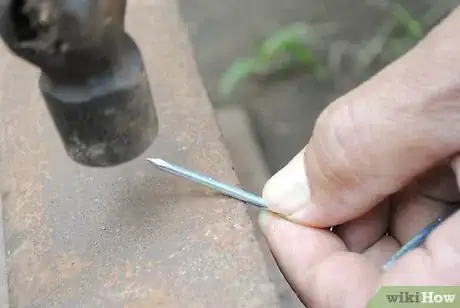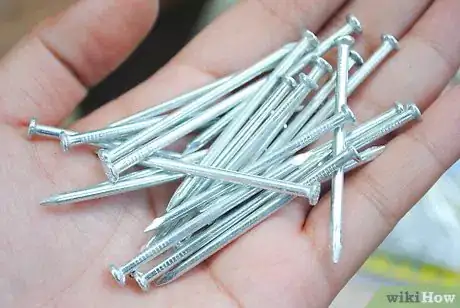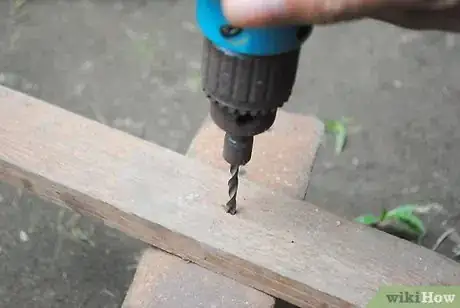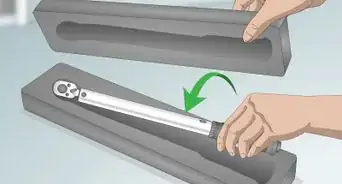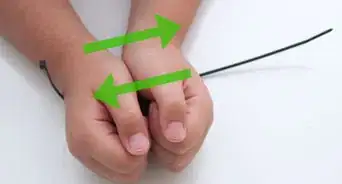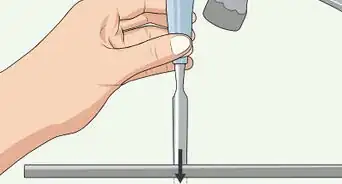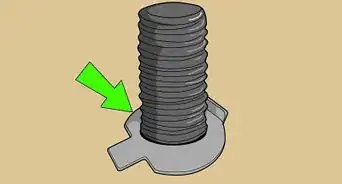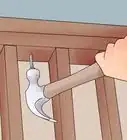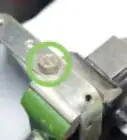X
wikiHow is a “wiki,” similar to Wikipedia, which means that many of our articles are co-written by multiple authors. To create this article, 18 people, some anonymous, worked to edit and improve it over time.
This article has been viewed 137,624 times.
Learn more...
When driving nails near edges or ends of hard, brittle, or knotty wood, you may have the misfortune of having a large crack appear, or even a piece of your lumber break out at the edge. There are a few ways of decreasing the likelihood of this happening.
Steps
-
1Blunt the point of the nail with your hammer. This is done by placing the nail on a hard surface with the point facing up, and tapping the sharp end with your hammer. The nail will then cut its way through the wood grain, rather than wedging a pathway. Though this puts all the material displacement along a single plain, rather than dispersing it all around the point of the nail.[1]
-
2Lubricate your nail. For especially hard woods like oak or maple, you may have better luck if you dip the nail in petroleum jelly, which reduces the friction of the driving process, and can decrease the probability of the wood splitting.[2]Advertisement
-
3Avoid nailing very near the edge or end of the board. Where end nailing is necessary, angle the nail so that it can be started farther away from the end, but the nail will still get a bite into the other board it is being nailed to.
-
4Use the smallest diameter nail which will do the job, or hold the workpieces securely. Obviously, a 16d or 20d nail, with its larger diameter, will exert more force on the wood's grain, making the wood more likely to split.
-
5Pre-drill a hole slightly smaller than the nail's shank diameter. For a 12d nail, about 3⁄32 inch (0.2 cm) will reduce the pressure of the nail penetration without decreasing the nail's grip on the board.[3]
-
6Use wood with sufficient moisture if possible. Very dry wood is more likely to split, since the drier the wood is, the less flexible it will be.[4]
-
7Use softwoods where they are suitable for your purposes, rather than hardwoods. Douglas Fir, Southern Yellow Pine, or Lodge pole Pine are less likely to split than are Oak, Birch, or Maple.[5]
-
8Avoid nailing through, or very near knots in the lumber. Knots are usually formed by heartwood, which is harder and less flexible than sapwood.
-
9Back any nail out if a crack begins to appear while driving it. A tiny crack is a sure indication the wood will split if you continue, possibly ruining a board if it is being used for trim work. You may have to look at choosing another location for your nail, further from the end or edge of the board, or pre-drill a hole for a wood screw or other fastening method.
-
10Finished.
Advertisement
Community Q&A
-
QuestionWhat size nails (diameter and length) should I use for installing shoe moulding?
 Community AnswerI would use ones that are small in diameter with small, rounded heads. Make sure they are long enough to grip into something solid after they've penetrated the shoe moulding (and possibly drywall). You want the penetration to be at least the thickness of your shoe moulding, but two times as much would be better. You can greatly reduce splitting with any nail by taking your hammer and flattening the pointed end with a few gentle strikes. Then, rather than separating the wood fibers, you'll be punching them out in the shape of that nail which reduces the splitting.
Community AnswerI would use ones that are small in diameter with small, rounded heads. Make sure they are long enough to grip into something solid after they've penetrated the shoe moulding (and possibly drywall). You want the penetration to be at least the thickness of your shoe moulding, but two times as much would be better. You can greatly reduce splitting with any nail by taking your hammer and flattening the pointed end with a few gentle strikes. Then, rather than separating the wood fibers, you'll be punching them out in the shape of that nail which reduces the splitting. -
QuestionShould I be concerned about wood splitting at a later date when using soft wood?
 Community AnswerNot overly.
Community AnswerNot overly. -
QuestionIs aged wood hardwood?
 Community AnswerNo. Hardwood is wood from broad-leaved temperate and tropical forest trees. Softwood is from gymnosperm trees such as conifers. Old-growth conifers like Southern Yellow Pine heartwood have a hardness scale similar to hardwoods. Hardness scale is different than hardwood.
Community AnswerNo. Hardwood is wood from broad-leaved temperate and tropical forest trees. Softwood is from gymnosperm trees such as conifers. Old-growth conifers like Southern Yellow Pine heartwood have a hardness scale similar to hardwoods. Hardness scale is different than hardwood.
Advertisement
Warnings
- Wear safety glasses when driving nails.⧼thumbs_response⧽
Advertisement
Things You'll Need
- Hammer, nails, and lumber
- Drill with small drill bits (optional)
References
- ↑ https://www.askthebuilder.com/preventing-wood-splitting-video/
- ↑ https://home.tips.net/T012530_Keeping_Nails_from_Splitting_Wood.html
- ↑ https://www.woodworkingnetwork.com/knowledge-center/wood-dr/splits-caused-nails-and-screws
- ↑ https://extension.purdue.edu/extmedia/FNR/FNR-163.pdf
- ↑ https://www.woodworkingnetwork.com/knowledge-center/wood-dr/splits-caused-nails-and-screws
About This Article
Advertisement
